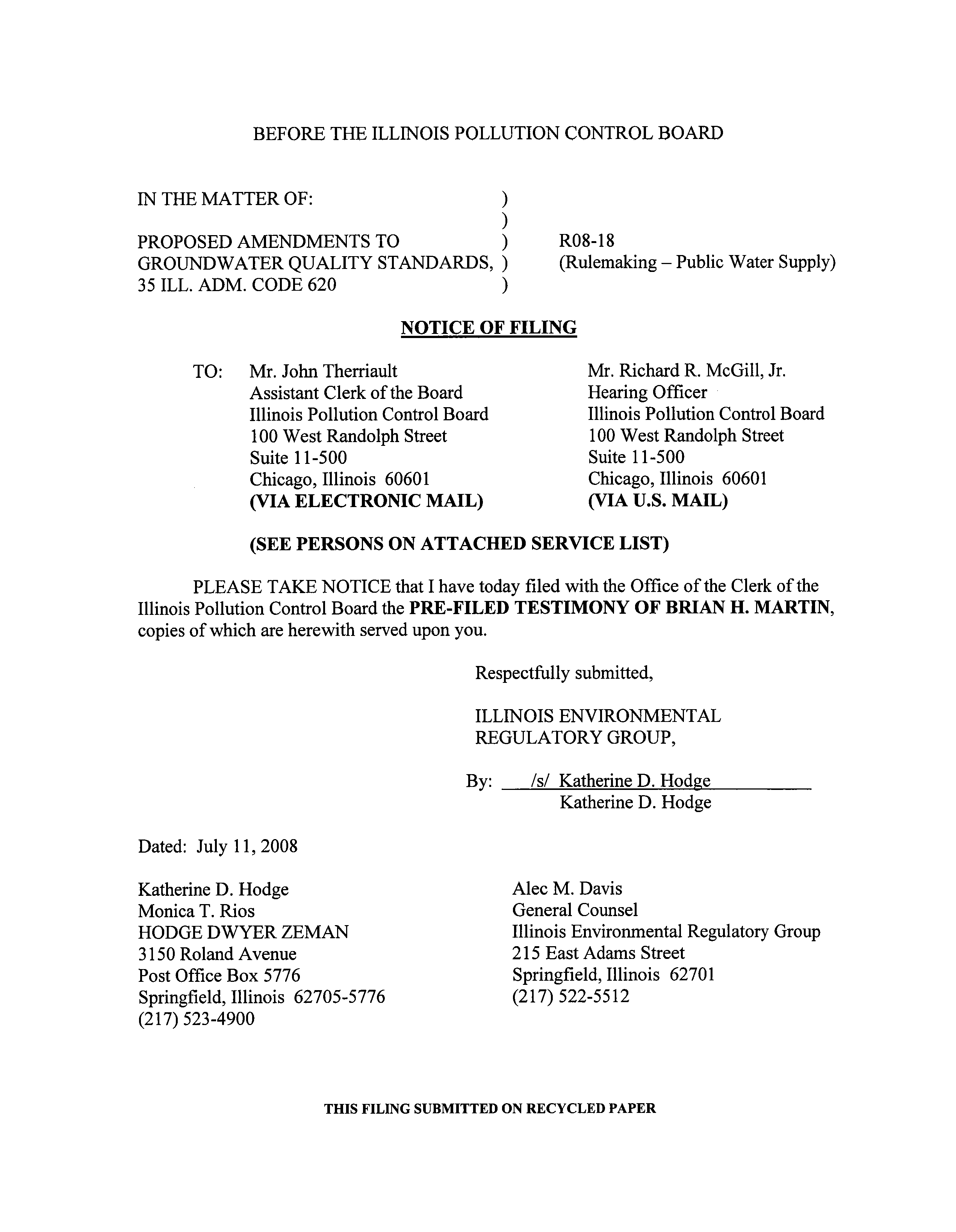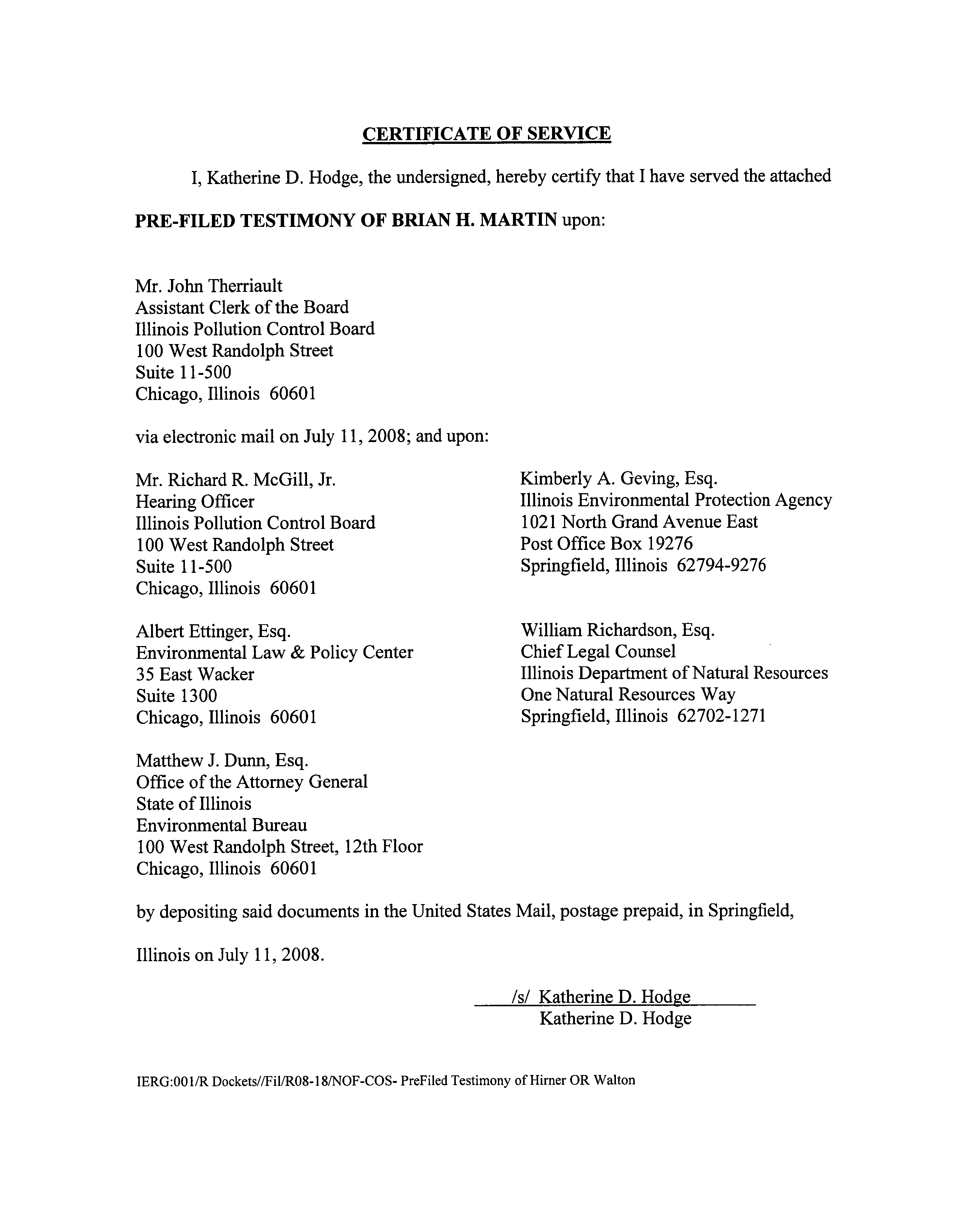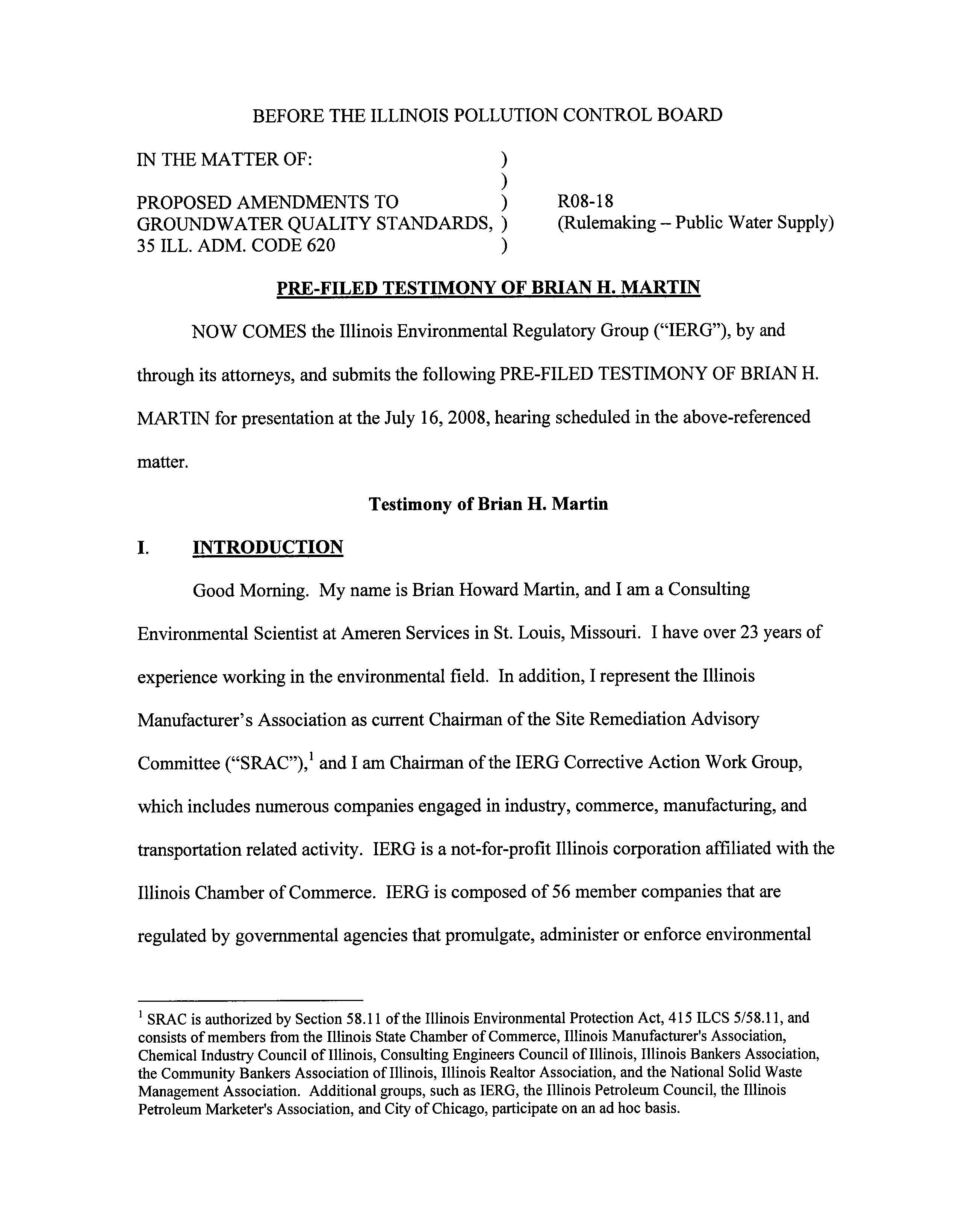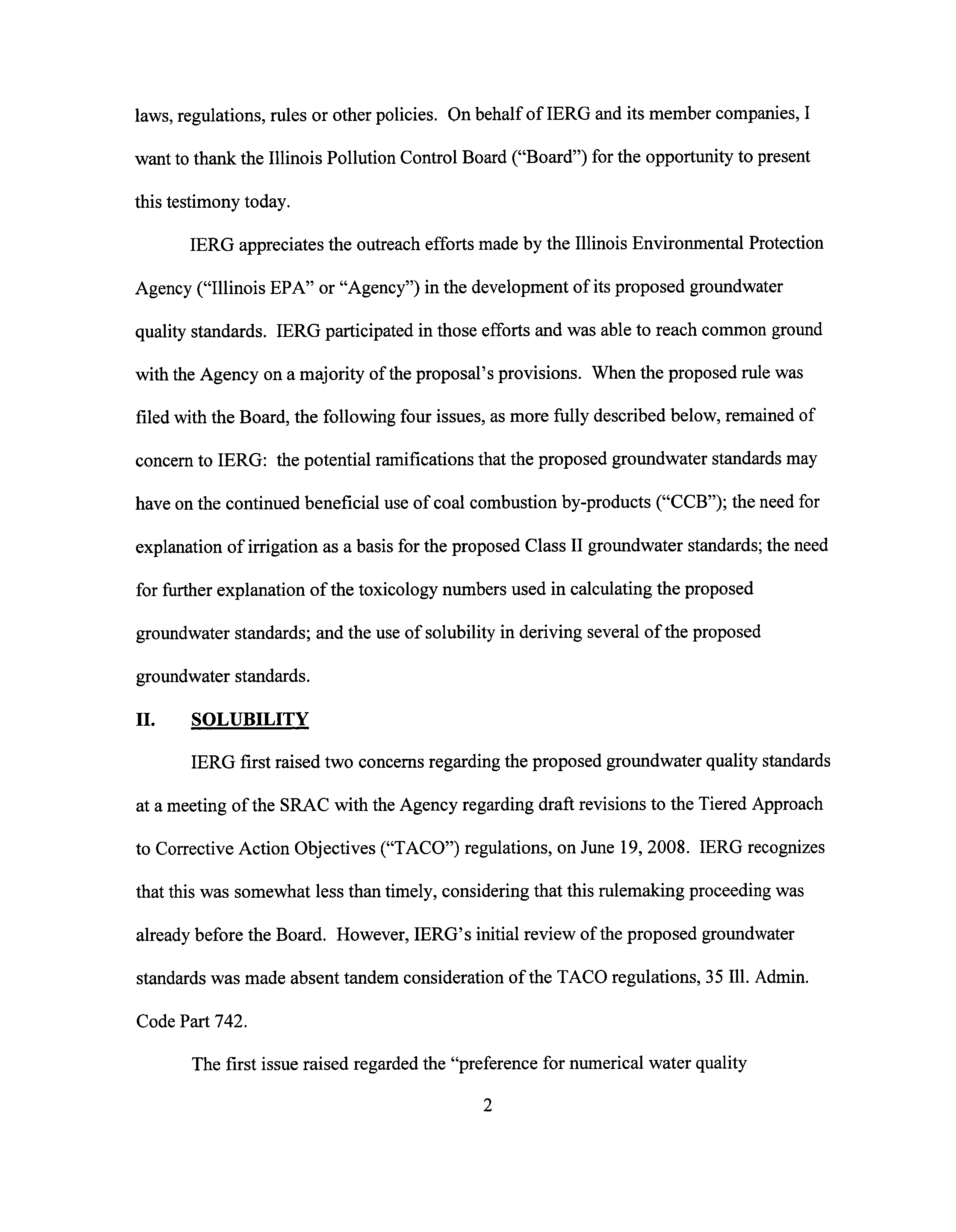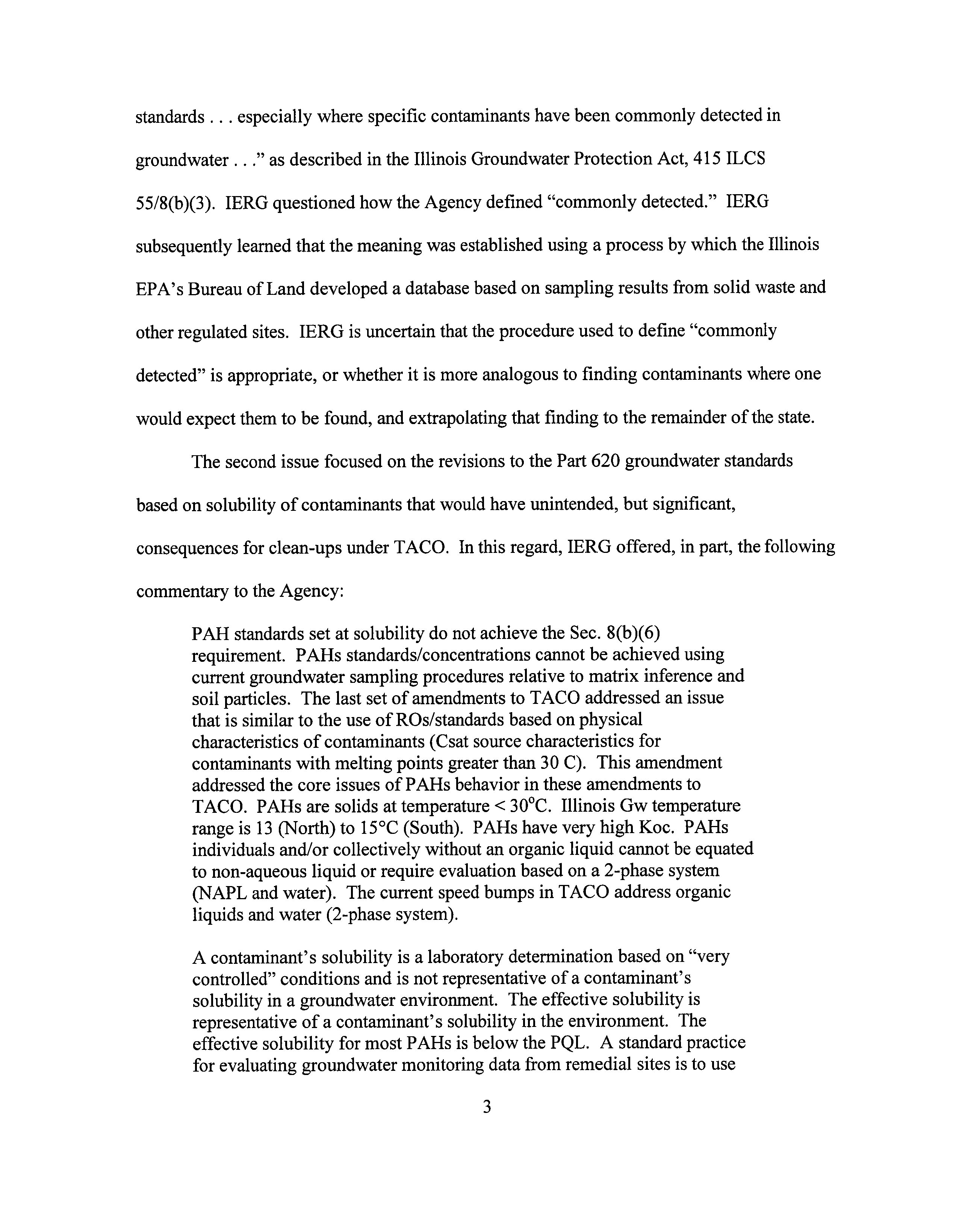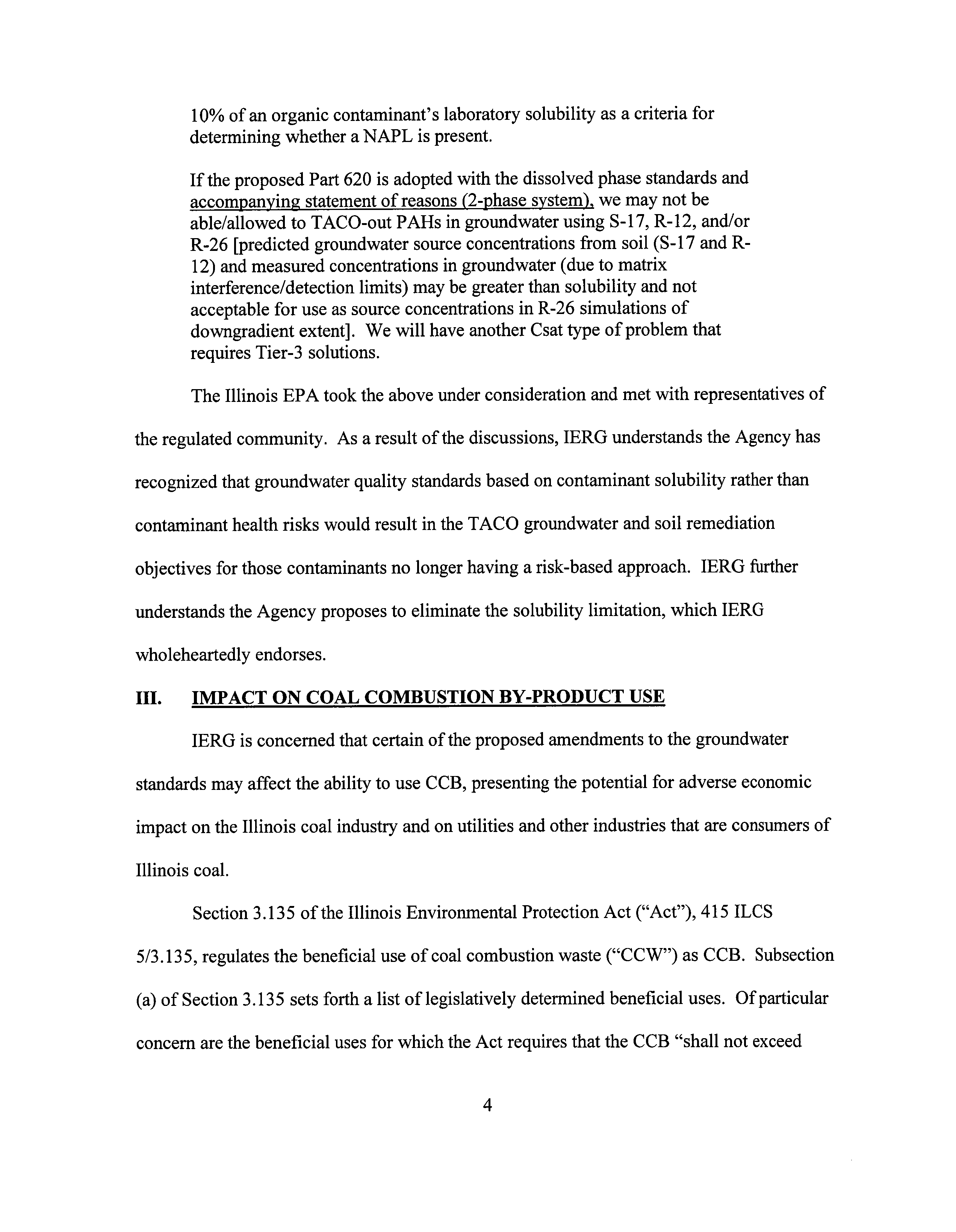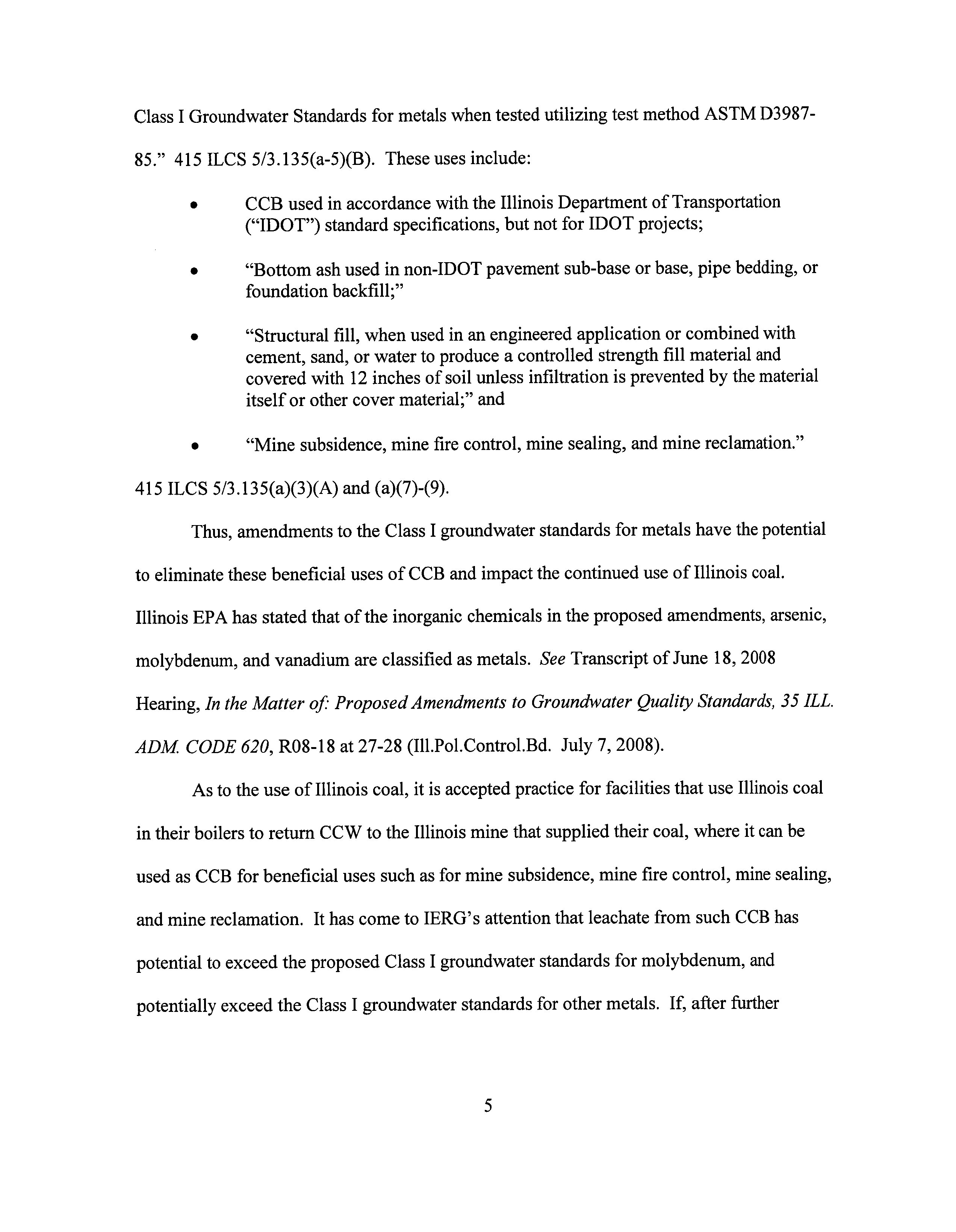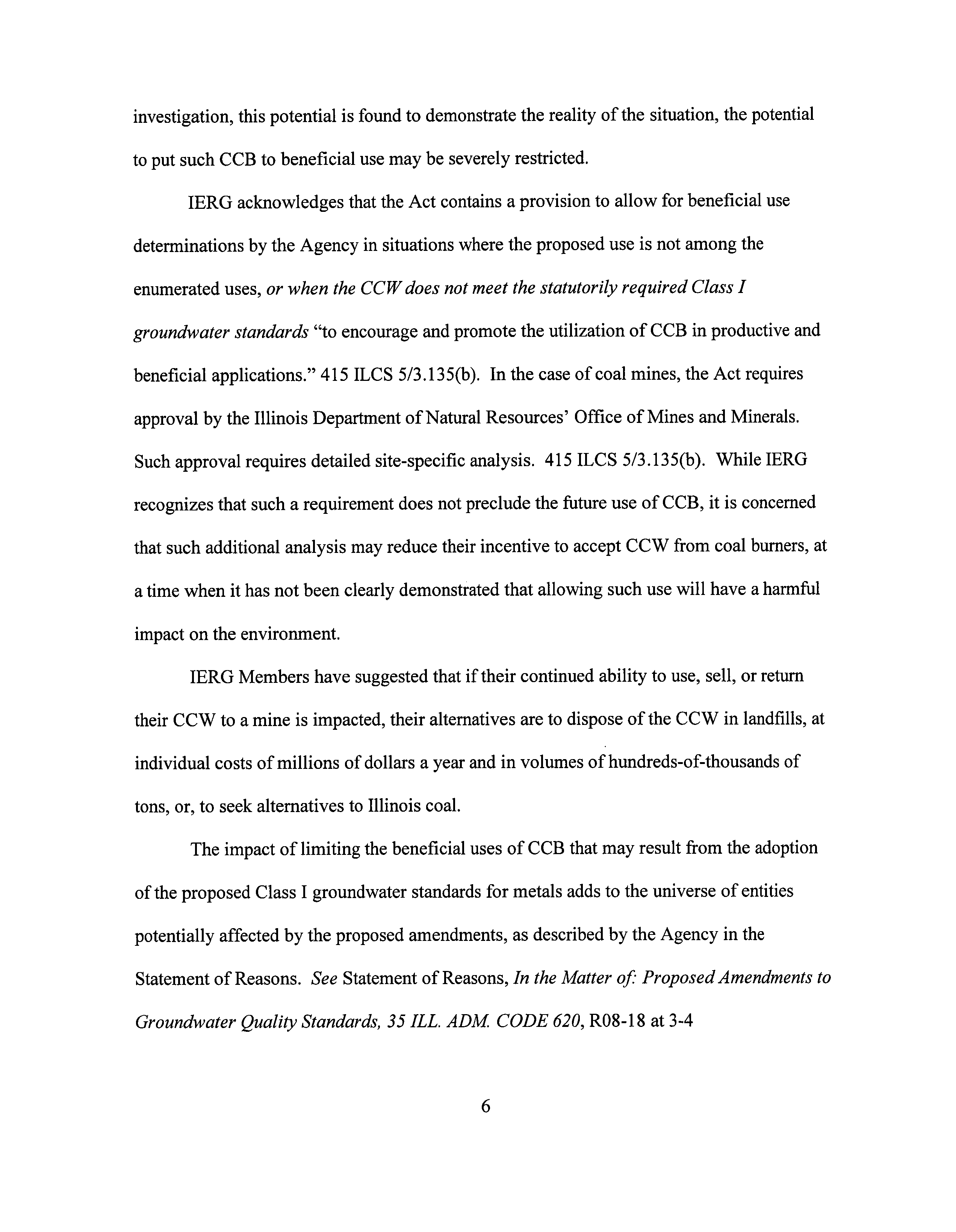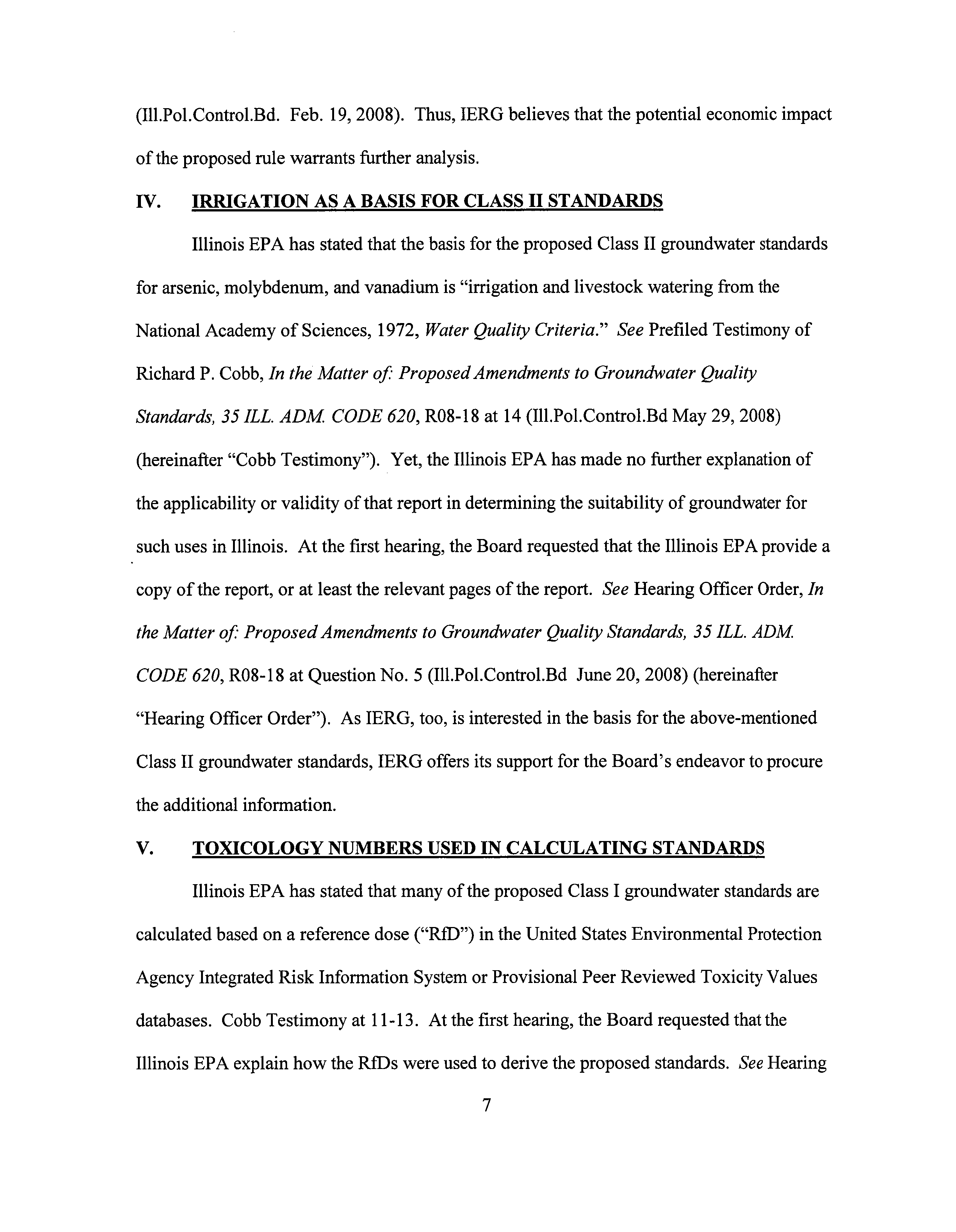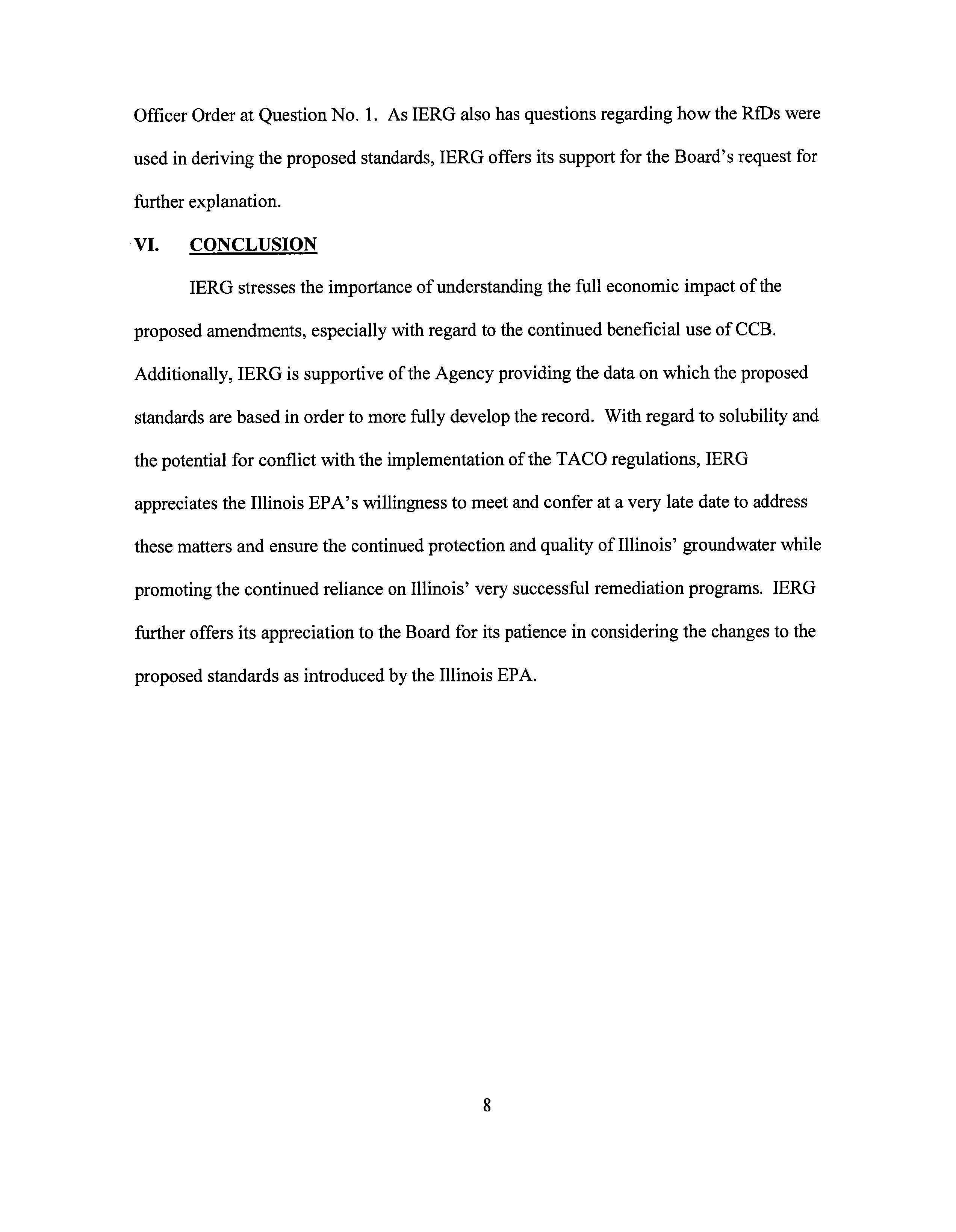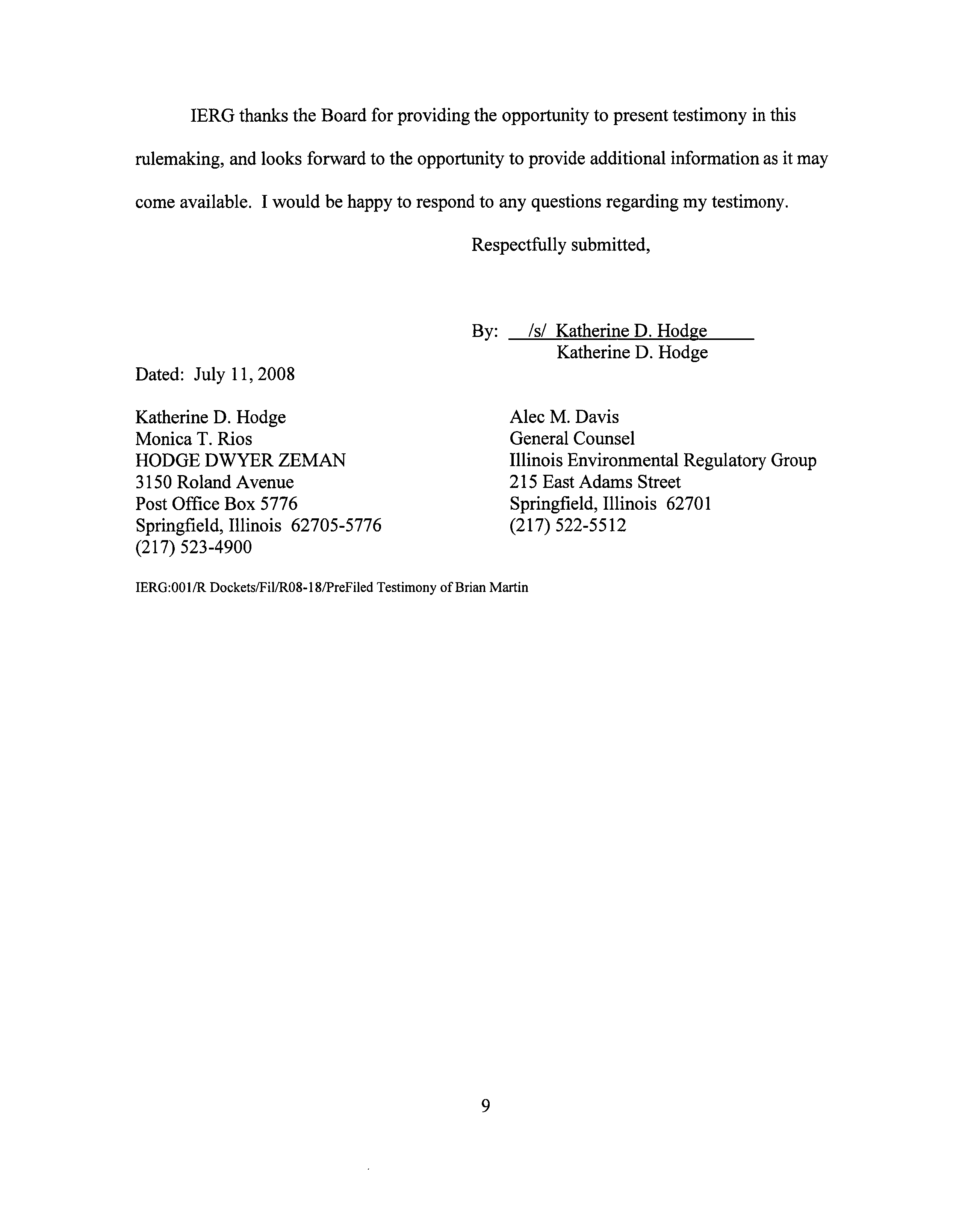BEFORE THE ILLINOIS POLLUTION CONTROL BOARD
IN THE
MATTER OF:
)
PROPOSED AMENDMENTS
TO
)
GROUNDWATER
QUALITY STANDARDS, )
35 ILL.
ADM. CODE 620
)
R08-18
(Rulemaking - Public Water Supply)
NOTICE OF FILING
TO:
Mr. John Therriault
Assistant Clerk of the Board
Illinois Pollution Control Board
100 West Randolph Street
Suite 11-500
C hicago,
Illinois 60601
(VIA ELECTRONIC
MAIL)
Mr. Richard R. McGill, Jr.
Hearing Officer
Illinois Pollution Control Board
100 West Randolph Street
Suite 11-500
Chicago, Illinois 60601
(VIA U.S. MAIL)
(SEE PERSONS ON ATTACHED SERVICE
LIST)
PLEASE TAKE NOTICE that I have today filed with the Office of the Clerk of the
Illinois Pollution Control Board the PRE-FILED
TESTIMONY OF BRIAN H. MARTIN,
copies of which are herewith served upon you.
Respectfully submitted,
ILLINOIS ENVIRONMENTAL
REGULATORY
GROUP,
By: /s/ Katherine D. Hodize
Katherine D. Hodge
Dated: July 11, 2008
Katherine
D. Hodge
Monica T. Rios
HODGE DWYER ZEMAN
3150 Roland Avenue
Post Office Box 5776
Springfield,
Illinois 62705-5776
(217) 523-4900
Alec M. Davis
General Counsel
Illinois
Environmental Regulatory Group
215 East Adams Street
S pringfield, Illinois 62701
(217) 522-5512
THIS FILING SUBMITTED ON RECYCLED
PAPER
Electronic Filing - Received, Clerks' Office, July 11, 2008
CERTIFICATE
OF SERVICE
I, Katherine D. Hodge,
the undersigned, hereby certify that I have served
the attached
PRE-FILED
TESTIMONY OF BRIAN H. MARTIN upon:
Mr. John Therriault
Assistant Clerk of the
Board
Illinois Pollution Control
Board
100 West
Randolph Street
Suite 11-500
Chicago, Illinois 60601
via electronic mail on July 11, 2008; and upon:
Mr. Richard R. McGill, Jr.
Hearing Officer
Illinois Pollution
Control Board
100 West
Randolph Street
Suite
11-500
Chicago, Illinois 60601
K imberly A. Geving, Esq.
Illinois Environmental Protection Agency
1021 North Grand
Avenue East
Post Office Box
19276
Springfield,
Illinois 62794-9276
A lbert Ettinger,
Esq.
Environmental Law & Policy Center
35 East Wacker
Suite 1300
C hicago, Illinois 60601
Matthew J. Dunn, Esq.
Office of the Attorney General
State of Illinois
Environmental
Bureau
1 00 West
Randolph Street, 12th Floor
Chicago, Illinois 60601
W illiam Richardson, Esq.
Chief Legal Counsel
Illinois Department of Natural Resources
One Natural Resources Way
Springfield, Illinois 62702-1271
by depositing said documents
in the United States Mail, postage prepaid,
Illinois on July 11, 2008.
in Springfield,
/s/ Katherine D. Hodge
Katherine D. Hodge
I
ERG:001/R
Dockets//Fil/R08-18/NOF-COS- PreFiled Testimony of
Hirner OR Walton
Electronic Filing - Received, Clerks' Office, July 11, 2008
BEFORE
THE ILLINOIS POLLUTION CONTROL BOARD
IN THE MATTER OF:
)
PROPOSED AMENDMENTS
TO
) R08-18
GROUNDWATER
QUALITY STANDARDS,)
(Rulemaking
- Public Water Supply)
35 ILL. ADM. CODE 620
)
PRE-FILED
TESTIMONY OF BRIAN H. MARTIN
NOW COMES the Illinois Environmental
Regulatory Group ("IERG"), by and
through its attorneys, and submits the
following PRE-FILED TESTIMONY OF BRIAN H.
MARTIN
for presentation at the July 16, 2008, hearing scheduled in the above-referenced
matter.
Testimony of Brian H. Martin
I. INTRODUCTION
Good
Morning. My name is Brian Howard Martin, and I am a Consulting
Environmental Scientist at Ameren Services in St. Louis,
Missouri. I have over 23 years of
experience working in the environmental
field. In addition, I represent the Illinois
Manufacturer's Association as current Chairman of the Site
Remediation Advisory
Committee ("SRAC"),1 and I am Chairman of
the IERG Corrective Action Work Group,
which
includes numerous companies engaged in industry, commerce, manufacturing, and
transportation related activity. IERG is a not-for-profit
Illinois corporation affiliated with the
Illinois Chamber of Commerce.
IERG is composed of 56 member companies that are
regulated by governmental agencies that promulgate,
administer or enforce environmental
' SRAC is authorized by Section 58.11 of the
Illinois Environmental Protection Act, 415 ILCS 5/58.11, and
consists of
members from the Illinois State Chamber of Commerce, Illinois Manufacturer's
Association,
Chemical Industry Council of Illinois, Consulting
Engineers Council of Illinois, Illinois Bankers Association,
the Community
Bankers Association of Illinois, Illinois Realtor Association, and the National Solid Waste
Management Association. Additional
groups, such as IERG, the Illinois Petroleum Council, the Illinois
Petroleum Marketer's Association, and City of Chicago, participate on an ad
hoc
basis.
Electronic Filing - Received, Clerks' Office, July 11, 2008
laws, regulations, rules or other policies. On
behalf of IERG and its member
companies, I
want to thank
the Illinois Pollution Control Board ("Board")
for the opportunity to present
this testimony today.
IERG appreciates
the outreach efforts made by the Illinois Environmental
Protection
Agency ("Illinois EPA" or "Agency") in the development
of its proposed groundwater
quality standards. IERG participated
in those efforts and was able to reach common ground
with the Agency on a majority of the proposal's provisions.
When the proposed rule was
filed with the Board, the following
four issues, as more fully described below, remained of
concern
to IERG: the potential ramifications that
the
proposed
groundwater standards may
have on the continued beneficial
use of coal combustion by-products ("CCB"); the need for
explanation of irrigation
as a basis for the proposed Class II groundwater standards; the
need
for further explanation of the toxicology numbers used
in calculating the proposed
groundwater standards; and the use
of solubility in deriving several of the proposed
groundwater standards.
II. SOLUBILITY
IERG first raised two concerns regarding the proposed
groundwater quality standards
at a meeting of the SRAC
with the Agency regarding draft revisions to the Tiered Approach
to Corrective
Action Objectives ("TACO") regulations, on June 19, 2008. IERG
recognizes
that this was somewhat less than timely, considering
that this rulemaking proceeding was
already before
the Board. However, IERG's initial review of the proposed groundwater
standards was made absent tandem consideration of the TACO
regulations, 35 Ill. Admin.
Code Part 742.
The first issue raised regarded the "preference
for numerical water quality
2
Electronic Filing - Received, Clerks' Office, July 11, 2008
standards ... especially where specific
contaminants have been commonly detected in
groundwater. . ." as described in the Illinois Groundwater
Protection Act, 415 ILCS
55/8(b)(3). IERG questioned
how the Agency defined "commonly detected." IERG
subsequently
learned that the meaning was established using a process
by which the Illinois
EPA's Bureau of Land developed
a database based on sampling results from solid
waste and
other regulated
sites. IERG is uncertain that the procedure used
to define "commonly
detected" is appropriate, or whether
it is more analogous to finding contaminants where one
would expect them
to be found, and extrapolating that finding to the remainder of the state.
The second issue focused on the revisions to the Part 620 groundwater
standards
based on solubility of contaminants
that would have unintended, but significant,
consequences
for clean-ups under TACO. In this regard, IERG offered,
in part, the following
commentary to the Agency:
PAH standards set at solubility do not achieve the Sec. 8(b)(6)
requirement. PAHs standards/concentrations
cannot be achieved using
current groundwater sampling
procedures relative to matrix inference and
soil particles. The last set
of amendments to TACO addressed an issue
that
is similar to the use of ROs/standards based on physical
characteristics of contaminants (Csat source characteristics for
contaminants with melting points greater than 30 C).
This amendment
addressed the core issues
of PAHs behavior in these amendments to
TACO. PAHs are
solids at temperature < 30°C. Illinois Gw temperature
range
is 13
(North)
to 15°C (South). PAHs have very high Koc. PAHs
individuals and/or collectively without an organic liquid cannot be equated
to non-aqueous liquid or require evaluation
based on a 2-phase system
(NAPL and water). The current
speed bumps in TACO address organic
liquids and water
(2-phase system).
A contaminant's solubility is a laboratory
determination based on "very
controlled" conditions and
is not representative of a contaminant's
solubility
in a groundwater environment. The effective solubility is
representative of a contaminant's solubility in the
environment. The
effective solubility for most PAHs is below the
PQL. A standard practice
for evaluating groundwater monitoring
data from remedial sites is to use
3
Electronic Filing - Received, Clerks' Office, July 11, 2008
10% of an organic contaminant's
laboratory solubility as a criteria
for
determining
whether a NAPL is present.
If the proposed Part 620 is adopted
with the dissolved phase standards and
accompanying statement of
reasons (2-phase system), we may not be
able/allowed to
TACO-out PAHs in groundwater using S-17,
R-12, and/or
R-26 [predicted
groundwater source concentrations
from soil (S-17 and R-
12) and
measured concentrations in groundwater
(due to matrix
interference/detection limits) may be
greater than solubility and not
acceptable for use as source
concentrations in R-26 simulations of
downgradient extent]. We
will have another Csat type of problem that
requires
Tier-3 solutions.
The Illinois EPA took the above under
consideration and met with representatives of
the regulated community.
As a result of the discussions,
IERG understands the Agency has
recognized that groundwater quality standards
based on contaminant solubility rather than
contaminant health
risks would result in the TACO groundwater
and soil remediation
objectives
for those contaminants no longer having a risk-based
approach. IERG further
understands the Agency proposes to eliminate
the solubility limitation, which IERG
wholeheartedly
endorses.
III. IMPACT ON COAL COMBUSTION BY-PRODUCT
USE
IERG
is concerned that certain of the proposed amendments
to the groundwater
standards may affect the ability to use CCB,
presenting the potential for adverse economic
impact on the
Illinois coal industry and on utilities and other industries
that are consumers of
Illinois coal.
Section 3.135 of the
Illinois Environmental Protection Act ("Act"), 415 ILCS
5/3.135, regulates the beneficial use of coal combustion waste
("CCW") as CCB. Subsection
(a) of Section 3.135 sets forth a list of legislatively
determined beneficial uses. Of particular
concern are
the beneficial uses for which the Act requires that the CCB
"shall not exceed
Electronic Filing - Received, Clerks' Office, July 11, 2008
Class I Groundwater Standards
for metals when tested utilizing
test method ASTM D3987-
85." 415 ILCS 5/3.135(a-5)(B). These
uses include:
"
CCB
used in accordance with the Illinois
Department of Transportation
("IDOT") standard specifications,
but not for IDOT projects,
"
"Bottom ash
used in non-IDOT pavement sub-base
or base, pipe bedding, or
foundation backfill;"
"
"Structural
fill, when used in an engineered application
or combined with
cement, sand, or water to produce
a controlled strength fill material and
covered with 12 inches of soil
unless infiltration is prevented by the
material
itself or other cover
material;" and
"
"Mine subsidence,
mine fire control, mine sealing, and
mine reclamation."
415 ILCS 5/3.135(a)(3)(A)
and (a)(7)-(9).
Thus, amendments
to the Class I groundwater standards for metals have the
potential
to eliminate
these beneficial uses of CCB and impact
the continued use of Illinois coal.
Illinois EPA has stated
that of the inorganic chemicals
in the proposed amendments, arsenic,
molybdenum, and vanadium are classified
as metals. See Transcript of June
18, 2008
Hearing, In the Matter of
Proposed Amendments to Groundwater
Quality Standards, 35 ILL.
ADM.
CODE
620, R08-18 at 27-28 (I11.Pol.Control.Bd.
July 7, 2008).
As to the use of Illinois coal,
it is accepted practice for facilities that use
Illinois coal
in their boilers
to return CCW to the Illinois mine that
supplied their coal, where it can be
used as CCB for beneficial uses such as for
mine subsidence, mine fire control, mine sealing,
and mine reclamation.
It has come to IERG's attention that
leachate from such CCB has
potential to exceed the proposed Class I groundwater
standards for molybdenum, and
potentially exceed the
Class I groundwater standards for other
metals. If, after further
Electronic Filing - Received, Clerks' Office, July 11, 2008
investigation, this potential
is found to demonstrate the reality of the situation,
the potential
to put such CCB to beneficial use may be
severely restricted.
IERG
acknowledges that the Act contains a provision to allow
for beneficial use
determinations by the Agency in situations where
the proposed use is not among the
enumerated uses, or when
the CCW does not meet the statutorily required Class
I
groundwater standards
"to encourage and promote the utilization
of CCB in productive and
beneficial applications." 415 ILCS 5/3.135(b).
In the case of coal mines, the Act requires
approval by the
Illinois Department of Natural Resources' Office of Mines and Minerals.
Such approval requires detailed site-specific
analysis. 415 ILCS 5/3.135(b). While IERG
recognizes
that such a requirement does not preclude
the future use of CCB, it is concerned
that such additional analysis may reduce
their incentive to accept CCW from coal burners, at
a time when it has
not been clearly demonstrated that allowing such use
will have a harmful
impact on the environment.
IERG Members have suggested
that if their continued ability to use, sell, or return
their CCW to a mine is impacted, their alternatives are to
dispose of the CCW in landfills, at
individual costs of millions of dollars
a year and in volumes of hundreds-of-thousands of
tons,
or,
to seek alternatives to Illinois coal.
The impact of limiting the beneficial
uses of CCB that may result from the adoption
of the proposed
Class I groundwater standards for metals adds to the universe
of entities
potentially affected by the proposed amendments,
as described by the Agency in the
Statement of Reasons. See
Statement of Reasons, In the Matter of Proposed Amendments to
Groundwater Quality Standards, 35 ILL. ADM. CODE
620, R08-18 at 3-4
Electronic Filing - Received, Clerks' Office, July 11, 2008
(I11.Pol.Control.Bd. Feb.
19, 2008). Thus, IERG believes that the potential economic impact
of the proposed rule warrants further analysis.
IV. IRRIGATION AS A BASIS FOR CLASS II STANDARDS
Illinois EPA has stated that the basis for the proposed Class II groundwater standards
for arsenic, molybdenum, and vanadium
is
"irrigation
and livestock watering from the
National
Academy of Sciences, 1972, Water Quality Criteria." See Prefiled Testimony of
Richard P. Cobb, In the Matter of
Proposed Amendments to Groundwater Quality
Standards, 35
ILL. ADM. CODE 620, R08-18 at 14 (I11.Pol.Control.Bd May 29, 2008)
(hereinafter "Cobb Testimony"). Yet, the Illinois EPA has made no further explanation of
the applicability or validity of that
report in determining the suitability of groundwater for
such uses
in Illinois. At the first hearing, the Board requested that the Illinois EPA provide a
copy of the report, or at least the relevant pages of
the report. See Hearing Officer Order, In
the Matter of Proposed Amendments to Groundwater Quality Standards, 35 ILL. ADM.
CODE 620, R08-18 at Question No. 5 (I11.Pol.Control.Bd
June 20, 2008) (hereinafter
"Hearing Officer Order"). As IERG, too, is interested in the basis for the above-mentioned
Class II groundwater standards, IERG offers its support for the
Board's
endeavor to procure
the additional
information.
V. TOXICOLOGY NUMBERS USED IN CALCULATING STANDARDS
Illinois EPA
has
stated
that many of the
proposed
Class I groundwater standards
are
calculated based on a reference dose ("Rf") in the United States Environmental Protection
Agency Integrated Risk Information System or
Provisional Peer Reviewed Toxicity Values
databases. Cobb Testimony at 11-13. At the first hearing, the Board requested that the
Illinois EPA explain how the RfDs
were used to derive the proposed standards. See Hearing
7
Electronic Filing - Received, Clerks' Office, July 11, 2008
Officer Order at Question No.
1. As IERG also has questions regarding how the RfDs
were
used
in deriving the proposed standards, IERG offers
its support for the Board's request for
further explanation.
VI. CONCLUSION
IERG stresses the importance
of understanding the full economic impact of the
proposed amendments,
especially with regard to the continued beneficial use of CCB.
Additionally, IERG is supportive of the Agency providing
the data on which the proposed
standards are based in order to more
fully develop the record. With regard to solubility and
the potential
for conflict with the implementation of the TACO
regulations, IERG
appreciates the Illinois
EPA's willingness to meet and confer at a very late date to address
these matters and ensure the continued protection and quality
of Illinois' groundwater while
promoting the continued reliance
on Illinois' very successful remediation programs. IERG
further offers its appreciation
to the Board for its patience in considering the changes to the
proposed standards as introduced by the Illinois EPA.
Electronic Filing - Received, Clerks' Office, July 11, 2008
IERG thanks the Board for providing the opportunity to present testimony in this
rulemaking, and looks
forward to the
opportunity
to provide additional information as it may
come available. I would be happy to respond to any questions regarding my testimony.
Respectfully submitted,
By: /s/ Katherine D. Hodge
Katherine D. Hodge
Dated: July 11, 2008
Katherine D. Hodge
Monica T. Rios
HODGE DWYER ZEMAN
3150 Roland Avenue
P ost Office Box 5776
Springfield, Illinois 62705-5776
(217) 523-4900
Alec M. Davis
General Counsel
Illinois Environmental Regulatory Group
215 East Adams Street
S pringfield, Illinois 62701
(217) 522-5512
I ERG:001/R Dockets/Fil/R08-18/PreFiled Testimony of Brian Martin
Electronic Filing - Received, Clerks' Office, July 11, 2008
